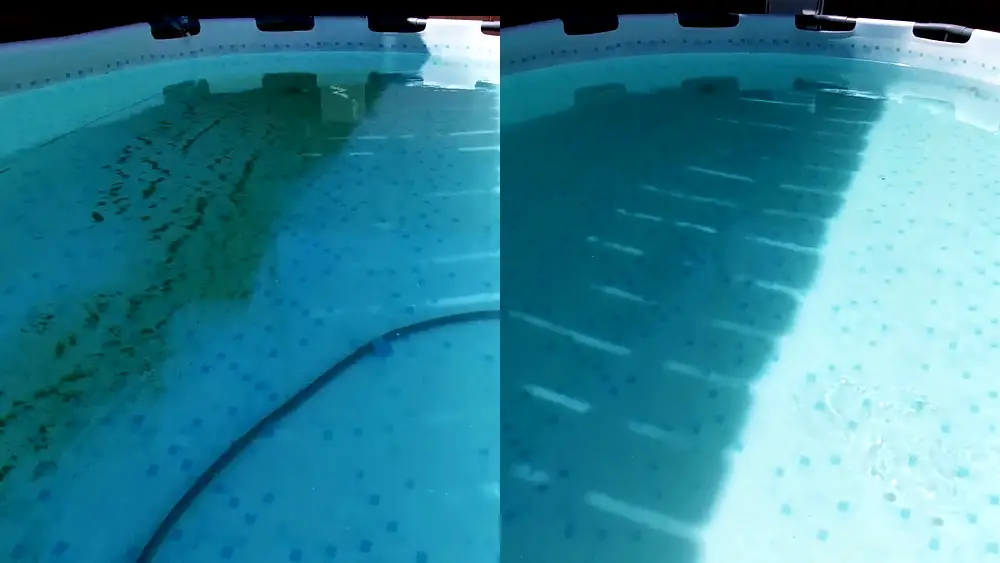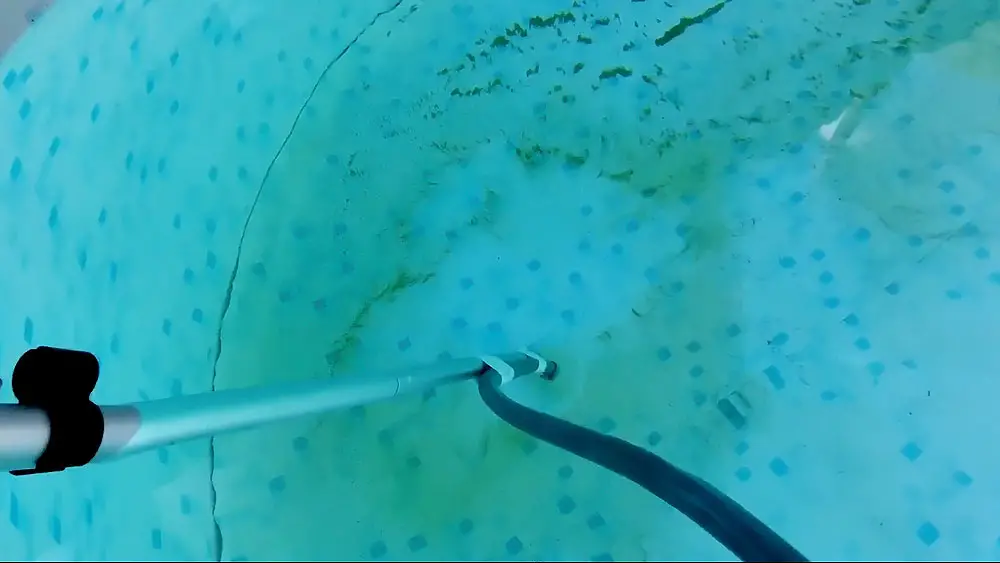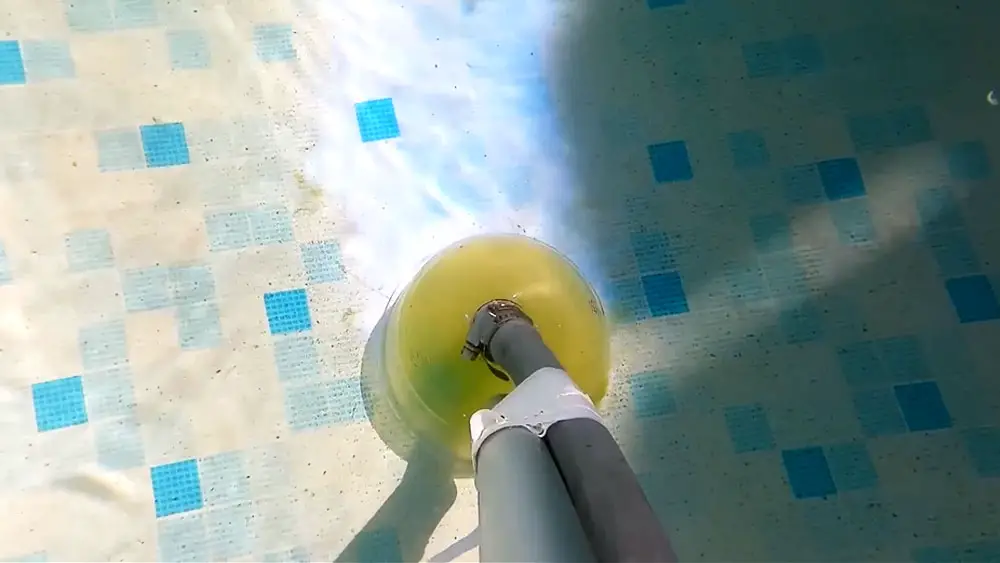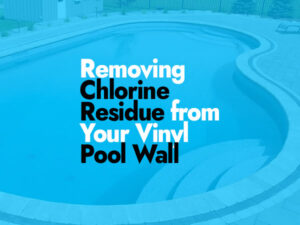Nothing beats swimming in your above-ground pool in the summer. However, when the pool is used, the bottom can collect dirt and debris, ruining your idyllic hideaway. Maintaining a clean pool bottom is easy with the appropriate knowledge. This comprehensive guide will walk you through cleaning the filth from the bottom of your above-ground pool.
We’ll cover tried-and-true ways to clean dirt on your above-ground pool bottom, from skimming to vacuuming and brushing. We’ll also discuss different cleaning methods that will change your routine. Automatic pool cleaners, enzyme-based treatments, and high-pressure water jets are convenient. We want to give you the tips and tricks to make pool upkeep easy.
Whether you’re an experienced pool owner or new to above-ground pools, this guide will help you clean with confidence. Roll up your sleeves and get ready to make your pool a glittering haven. Let’s discover how to keep a clean bottom for a fun summer in the water.

Above-Ground Pools Have What at the Bottom?
The bottom of an above-ground pool is mostly dirt, particulates, and organic matter that accumulates over time. This collection often includes dirt, leaves, grass, insects, dust, and other small objects brought into the pool. These are carried by wind, rain, or swimmers. Microscopic algae and bacteria may also build up on the pool bottom.
As water filters through the pool, heavier particles sink to the floor. Gravity and lack of water circulation in some pool regions cause these particles to settle and form a sediment layer. If left unchecked, this sediment, known as “pool dirt,” can damage the pool’s aesthetics, water quality and cleanliness.
This collection of contaminants at the bottom of an above-ground pool requires regular maintenance and cleaning. Pool netting and skimming prevent heavier material from sinking. To maintain water balance, pool owners must vacuum and brush the pool bottom and filter and chemically treat it regularly.
How Does Above-Ground Pool Dirt Collect?
Natural and environmental sources cause above-ground pool dirt collection. Dirt comes from wind, rain, and vegetation. Leaves, twigs, pollen, and dust are often blown into pools and settle on the water. Weight causes some of these particles to sink, adding dirt to the pool’s bottom.
Pool swimmers can also add dirt. Swimmers’ sunscreen, body oils, and cosmetics can form a thin film on the water’s top that breaks down and adds to the trash at the bottom. As swimmers enter and exit the pool, they may bring dirt and debris from the outside.
Microbes like algae and bacteria can also build soil. Wind or polluted pool equipment can spread algae spores, which proliferate quickly in sunlight and nutrients. These microbes develop and die, adding to the pool’s silt.
Poor water circulation and filtration can increase dirt buildup. Stagnant water increases debris collecting in pools with poor circulation. Inadequate filtration prolongs particle suspension in water, increasing their chances of sinking.
Why Is Above-Ground Pool Dirt Buildup Important?
Dirt buildup in above-ground pools is crucial for safety, water quality, and aesthetics. The appearance of a pool is important to its enjoyment. Dirty pool bottoms can soon turn the paradise into a murky, uninviting place. A clean pool improves the atmosphere and lets swimmers enjoy the water without dirt.
Proper pool upkeep also affects water quality. Dirt and trash can nourish algae and bacteria. These uninvited guests can obscure and discolor pool water and jeopardize sanitation. If uncontrolled, poor water quality can cause swimmers skin and eye irritations and health hazards.
Addressing dirt accumulation improves safety. The pool bottom detritus can hide difficulties that swimmers can trip over or get trapped in. Foreign items can also disrupt the pool’s filtration and circulation systems, affecting water quality and equipment.
The pool lasts longer when dirt is regularly removed. Bottom sediment can corrode or degrade the pool’s structure and materials. Long-term repairs and maintenance may be pricey.
How to Clean Dirt From the Bottom of Your Above-Ground Pool
Keeping your above-ground pool clean is crucial for safe, pleasurable swimming. Debris and grime can build at the bottom, making clean waters murky. Do not worry! With a little work, you can clean your pool again. This article will show you how to clean the filth off the bottom of your above-ground pool step-by-step, so you may dive in with confidence.

Step 1: Gather Cleaning Supplies
Before cleaning, you need the correct tools. A pool net or skimmer to collect heavier material, an above-ground pool vacuum, a telescopic pole to attach them, and a pool brush to remove stubborn dirt are needed. Maintain your pool’s filtration system by cleaning and maintaining the filter.
After preparing your tools, skim the pool to remove leaves, insects, and floating debris. This first step prevents bigger particles from sinking during cleaning. A clean surface improves future stages.
Step 2: Empty and Clean Skimmer and Pump Baskets
A blocked skimmer or pump basket can limit filtration system efficiency and cleaning efficacy. Turn off the pump and remove the skimmer and pump baskets. Clean up any debris, rinse, and return to their places. This ensures the filtration system removes dirt and particles from water.
Step 3: Attach Pool Vacuum and Brush
Time to clean up the pool’s bottom filth. Hook the pool vacuum head to the telescopic pole and the vacuum hose to it. To guarantee water flow, keep the vacuum hose tangle-free. Drop the vacuum head into the pool gently so the hose sinks and fills with water, eliminating air pockets. Connect the hose to the pool’s skimmer or suction port after placing the vacuum head on the floor.
Before vacuuming with the vacuum and pole, brush your pool. Scrub the pool floor with the pool brush on the telescopic pole, focusing on debris and algae. Brushing loosens dirt so the vacuum can suction it.
Step 4: Vacuum
Start vacuuming by turning on the pump after setting up the vacuum. Pump suction draws water through the vacuum line, bringing dirt and debris into the pool’s filtration system. Slowly sweep the vacuum head across the pool floor, covering every inch. Pay special attention to dirt-prone corners, fissures, and pool walls.
This operation must be done slowly to allow the vacuum to catch all the dirt. Rushing can lead to incomplete cleaning. A sudden drop in vacuum pressure may signal that the basket is full and has to be emptied.
Step 5: Empty Vacuum Basket and Rinse Filter
Dirt and debris will fill the vacuum basket. Check the basket often and empty it when half full. Failure to empty the basket might diminish vacuum efficiency and cause jams. The pool filter will also collect dirt while vacuuming. Turn off the pump and rinse the filter as directed by the manufacturer to optimize the filtering system.
Step 6: Regular Pool Maintenance
Prevention is the best way to avoid dirt buildup. Regular pool care keeps your pool clean and appealing. Clean the skimmer and pump baskets and skim the surface daily to remove leaves and debris. Check and adjust pool water chemistry to prevent algae and sediment buildup. Maintaining a regimen reduces deep cleaning frequency and intensity.
Step 7: Consider Pool Covers
A pool cover can reduce debris entering your pool. A cover keeps leaves, insects, and other debris out of the water. This can greatly minimize skimming and vacuuming, making pool maintenance easier.
Step 8: Keep an Eye on Algae Growth
Algae growth can cause pool bottom dirt. Regularly check pool walls and floors for algae. Treat any greenish or slimy spots immediately. Shock the pool with the right chemicals, follow the dosage, and brush off the algae. A clean pool surface traps less filth.
Step 9: Enjoy Your Clean, Inviting Pool
After cleaning and checking your pool’s filtration system, enjoy your hard work. Your above-ground pool now has clean, sparkling water for swimming. This pleasant setting may be maintained throughout the swimming season with regular maintenance and cleaning.
Cleaning the dirt from an above-ground pool’s bottom takes time and method. Following these procedures will help you clean and enjoy your pool for yourself, your family, and your guests.
Alternative Above-Ground Pool Bottom Cleaning Methods
In addition to utilizing a pool vacuum, above-ground pool owners can try other methods to clean the bottom. These methods differ in effectiveness and ease, so choose the one that best meets your pool’s demands and maintenance preferences.

Auto Pool Cleaners
Automatic pool cleaners are modern and convenient for above-ground pool cleaning. Each variety has its unique cleaning technique. Suction-side cleaners employ the pool’s filtration system to suck dirt and debris into their skimmer or dedicated suction line. Pressure-side cleaners travel around the pool and bag detritus. But robotic cleaners have their own motors and filtration systems. They have modern technology, efficient cleaning patterns, and independence from the pool’s filtration system.
For instance, robotic cleaners clean hands-free. Some models incorporate remote control and programmable cleaning cycles for the pool’s floor, walls, and waterline. While automatic cleaners are expensive, they save time and effort over time. Choose a cleaner that fits your pool’s size, shape, and needs.
Enzymes Pool Cleaners
Enzyme-based pool cleansers purify water and reduce filth and debris differently. Naturally occurring enzymes can break down organic stuff like oils, lotions, and other pool water pollutants. Add enzyme-based cleansers directly to water to speed up natural breakdown. They prevent scum lines on pool walls and surfaces, making the environment cleaner.
Enzyme-based cleaners won’t replace vacuuming and brushing, but they can reduce organic debris at the pool’s bottom. This may reduce cleaning frequency and intensity. Pool equipment and water chemistry are safe with enzyme treatments, making them a practical way to clean pools.
High-Pressure Water Jets
Pressure washer-powered high-pressure water jets clean pool bottoms and walls effectively. This approach uses a powerful jet of water to force dirt particles toward the pool’s drain or skimmer. High-pressure jets can remove algae, grime, and other deposits that brushes and vacuums cannot.
High-pressure water jets can damage the pool’s liner or surface if used improperly. Start with low pressure and raise as needed. Also, slant the water stream to avoid injuring the pool surface. This procedure is great for deep cleaning or supplementing routine maintenance.
Flocculent Treatment
A chemical treatment called flocculant removes tiny particles from water. These particles clump together and sink to the pool bottom when flocculent is introduced. A vacuum can easily remove these particles as they settle.
Flocculent should be used according to product directions. Diluting the flocculent in a bucket of water and equally distributing it throughout the pool is typical. Turn off the pool’s circulation system after a brief time to let particles settle. Use a pool vacuum to carefully remove clumped particles from the bottom after settling.
Floculent therapy can collect fine particles that filtering cannot. This procedure takes longer than vacuuming and may require more attention. Proper water chemistry is also necessary for flocculent treatment.
Shoveling and Scooping Manually
Manually scooping and sweeping leaves, sticks, and other detritus from the pool bottom is laborious. This procedure is useful for periodic deep cleaning or eliminating material that a pool net or vacuum cannot gather.
To manually scoop and shovel, use a pool-specific scoop or handheld net to gather trash from the surface and bottom. Avoid disturbing the pool’s water and dirt by being gentle. This procedure needs patience and attention to detail to collect all visible particles.
Manual scooping and shoveling are time-consuming but effective for removing heavy dirt that sinks. This procedure is often used with others to clean thoroughly.
Each above-ground pool bottom cleaning method has advantages and disadvantages. Your pool’s size, condition, and preferences determine which approach or combination of methods is ideal for you.
Common Above-Ground Pool Bottom Dirt Sources
The bottom of above-ground pools can collect dirt and debris from many sources. Understanding these typical sources is crucial for pool cleanliness and maintenance.
Environmental Waste
The natural world helps dirt accumulate at above-ground pool bottoms. The wind might blow debris into the pool. Tree leaves can be carried by air and water, sometimes dry and light and sometimes wet and heavy from rain. Twigs, grass clippings, and other organic items can also ride the wind and land on the pool’s surface. As these materials soak water and gain weight, gravity drags them down, forming a pool bottom trash layer.
Airborne Particles
Airborne particles like dust and pollen are everywhere outside. These tiny particles are easily swept up by wind and can travel long distances before gently settling into the ocean. As pool activity or rainfall moistens these particles, they lose buoyancy and drop to the bottom. This steady accumulation of small particles creates the silt layer pool owners face.
Bugs and Insects
Water is tempting for people but dangerous for insects and bugs. Beetles, flies, and ants may enter the pool due to its sheen. Unfortunately, many of these insects may fall into the pool and become caught on the surface. As they fight to escape, they can tire and sink into the pool, adding to its debris.
Body Oils and Sunscreen
Swimmers apply sunscreen, lotions, and oils before entering the pool to protect their skin from the sun and hydrate it. When these compounds mix with water, they form a thin layer that floats on the pool surface. Water movement and the natural breakdown of these compounds can erode this film and form a residue on the pool floor.
Microbes and Algae
Outdoor habitats contain algae, microscopic water plants, and bacteria. Wind can carry these minute entities into pool water. Sunlight and minerals in the pool foster their growth once introduced. Algae multiply quickly, leaving water areas green or slimy. As these patches perish, they add to pool bottom matter.
Human Activities
Humans can unintentionally pile more debris around the pool. Swimmers from sandy areas might transmit sand and soil into the pool via their bodies or clothing. Clothing surrounding the pool can also transport dust and dirt, which can enter the water.
Rainfall Runoff
Rainwater can clean the pool, but it can also bring filth and debris. Rainwater accumulates contaminants from the air and surroundings. Rainwater can wash leaves, dirt, and other debris into the pool, increasing trash concentration.
Nearby Landscaping
The landscaping around a pool can accidentally collect dirt. Trees, shrubs, and plants lose leaves, flowers, and other organic waste, especially in windy conditions. Lawn mowing and tree cutting can potentially introduce dirt and debris to the pool.
Environmental Conditions
Extreme weather can damage pool cleanliness. Storms with severe winds and dust can dump a lot of debris into the pool. Dust storms can carry large volumes of dirt long distances, generating a rapid and dramatic rise of dirt at the pool’s bottom.
Poor Maintenance
Avoiding dirt accumulation requires regular and comprehensive maintenance. Preventing debris from settling requires skimming the pool, good filtration, and good water circulation. Without these maintenance methods, particles that would otherwise be collected and removed can remain in the water and silt the pool floor.
Pool owners may create successful maintenance routines and tactics to maintain their above-ground pools clean, inviting, and fun for all users by knowing and tackling these typical dirt sources.
How Often Should Dirt Be Removed From Your Above-Ground Pool’s Bottom?
The environment, pool usage, and maintenance efficiency determine how often an above-ground pool’s bottom needs cleaning. Regular cleaning should be proactive to maintain pool conditions.
A weekly cleaning program is ideal for most above-ground pools. This frequency prevents leaves, insects, and other detritus from accumulating at the pool’s bottom. Skimming the water’s top with a pool net prevents heavier material from sinking, decreasing pool floor maintenance.
The cleaning schedule may need to be adjusted in certain situations. Pools in windy or treed regions may need cleaning every several days. Pools with heavy use or parties may need more attention to prevent dirt buildup.
Weekly or biweekly pool bottom vacuuming should accompany skimming. Vacuuming removes tiny dirt and particulates. Automatic pool cleaners can also keep the pool bottom clean by covering and removing dirt.
Water testing and chemical upkeep are also important for pool care. Proper water balance prevents algae growth and other dirt-building issues. Regularly checking and adjusting chemical levels reduces dirt removal.
Can Dirt at Your Above-Ground Pool’s Bottom Influence Water Clarity?
Dirt at the bottom of an above-ground pool can affect water quality and clarity. Dirt and debris on the pool floor can cause many water quality issues.
Discolored Water
Dirt and debris near the pool bottom might release organic chemicals and particles. Discoloration can make water foggy or murky. This vision impairment reduces the pool’s aesthetics and makes it hard to see its bottom, which is unsafe.
Low Water Circulation
Dirt can slow pool water circulation. Maintaining water temperatures and dispersing chemicals requires proper water circulation. Debris can choke pool filtration systems, causing stagnation and uneven chemical distribution.
Algae Growth
Dirt and debris feed algae. Most habitats contain algae spores, which can proliferate swiftly in favorable conditions. Excess soil nutrients can cause algae growth, turning water green and making it dangerous to swim in.
Bacteria Grow
Dirt might also promote bacterial growth. Organic matter breeds hazardous bacteria, and dirt grows them. This can lower water quality, promote waterborne infections, and cause odors.
Chlorine Inefficiency
Dirt can devour water chlorine. Sanitizing the pool and preventing microorganism growth requires chlorine. Dirt absorbs chlorine, reducing disinfection levels. This can impair water sanitation and quality.
Low Filtration Efficiency
A coating of dirt on the pool floor might strain the filtration system. More quickly clogged filters lower filtration efficiency. Poor filtration allows suspended particles to linger in the water, causing cloudiness and poor water quality.
Regular cleaning and maintenance ensure water clarity and quality. The pool must be properly filtered, chemically balanced, and skimmed to remove floating debris and settled dirt.
Frequently Asked Questions
How often should I clean my above-ground pool bottom?
Use, location, and weather determine how often you clean the bottom of your above-ground pool. Regular weekly cleaning is advised. Using a pool net or skimmer to skim the surface prevents debris from sinking. Weekly to bi-weekly vacuuming and brushing. To maintain water quality, alter cleaning frequency if dirt, leaves, or algae accumulate.
Can I clean the pool bottom with home cleaners?
Do not clean your pool using household goods. These products expose water to hazardous chemicals and pH imbalance. Instead, use pool-specific cleaning tools and chemicals to maintain pool chemistry and cleanliness without hurting water or equipment.
Can I clean the pool bottom while it’s full?
Yes, clean the pool bottom when it’s full. Draining an above-ground pool for cleaning is unnecessary and can damage it. Cleaning tools and equipment are designed to function successfully while the pool is filled to maintain water balance and prevent damage.
How can I know if my pool filter needs cleaning during vacuuming?
Monitor your pool’s filtration pressure gauge. Increased pressure may suggest a blocked filter that needs cleaning. If the pressure remains high after cleaning the skimmer and pump baskets, the filter needs maintenance. Rinsing or backwashing the filter as directed by the manufacturer will keep water circulation and filtration efficient.
Can I pressure-wash the pool bottom?
A pressure washer can clean the pool floor, but be careful. Use a pressure washer with the right PSI to protect the pool’s surface and liner. To avoid damage and remove dirt, apply pressure at an angle. Pressure washing can remove tough grime, but it doesn’t substitute pool cleaning.
How long should I run my pool pump and filter while cleaning?
For proper water circulation and filtration, run your pool pump and filter system 8–12 hours daily. Maintain pump runtime or change it slightly to accommodate vacuuming and filtration during cleaning sessions. Proper circulation distributes chemicals, prevents algae, and maintains water quality.
Can bleach clean my pool bottom?
Bleach can disinfect surfaces, but not pool bottoms. Bleach can induce chemical imbalances in water, endangering swimmers and pool equipment. Use pool-specific cleaners and appliances to maintain water balance and cleanliness.
Can I swim right after pool bottom cleaning?
If the water’s chemistry is balanced and any added chemicals have dissipated, you can swim after cleaning the pool bottom. Swimmers should enter the pool after chlorine and pH levels are checked. Before swimming, wait for chemicals to disperse or water to settle, depending on the cleaning procedure.
Can I clean the pool bottom in winter?
Since the pool is rarely used in winter, cleaning the bottom is usually unnecessary. Spend time winterizing your pool to avoid harm from freezing weather. Reopening the pool after the swimming season requires rigorous cleaning and upkeep.
How can I avoid pool bottom silt buildup?
Regular pool upkeep and care to prevent dirt buildup. Skim leaves and debris from the pool regularly and clean skimmer and pump baskets as needed. Keep the pool’s water chemistry balanced to avoid algae and sediment. Use a pool cover while not in use to reduce debris. A well-maintained pool has less filth at the bottom, making cleaning easier.
Final Words
Cleaning the bottom of an above-ground pool is vital for a nice swim. From skimming to vacuuming and brushing, you can remove dirt and debris efficiently. Automatic pool cleaners, enzyme-based treatments, and high-pressure water jets can also help clean your pool. Regular maintenance and dirt prevention can extend the life of your pool and provide clear waters for many swims. Remember, a clean pool improves beauty and health and safety.







